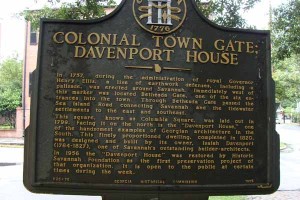To highlight this year’s Georgia History Festival theme, “A Legacy of Leadership,” February’s #MarkerMondays explore the history of the Colony of Georgia and it’s first city, Savannah.
 This week’s #MarkerMonday highlights the colonial town gate of Savannah, near the present-day site of the Isaiah Davenport House. Originally built in 1820 by architect Isaiah Davenport and restored by the Historic Savannah Foundation in 1956, the site of the Davenport House also holds significance for Georgia’s colonial history. During the Royal Colony era of Georgia’s history (1752-1776), Governor Henry Ellis and his administration worked to establish good relations with the Creek Nation, thereby securing an ally against the French during the French and Indian War (1754-1763). Governor Ellis also worked to fortify the City of Savannah against the threat of invasion by potential enemies such as the French, Native Americans, and pirates. In 1757, a line of earthwork defenses and palisades, or a defensive wall, were erected around the city. The city could be accessed from the surrounding area through six different gates or at the city’s docks.
This week’s #MarkerMonday highlights the colonial town gate of Savannah, near the present-day site of the Isaiah Davenport House. Originally built in 1820 by architect Isaiah Davenport and restored by the Historic Savannah Foundation in 1956, the site of the Davenport House also holds significance for Georgia’s colonial history. During the Royal Colony era of Georgia’s history (1752-1776), Governor Henry Ellis and his administration worked to establish good relations with the Creek Nation, thereby securing an ally against the French during the French and Indian War (1754-1763). Governor Ellis also worked to fortify the City of Savannah against the threat of invasion by potential enemies such as the French, Native Americans, and pirates. In 1757, a line of earthwork defenses and palisades, or a defensive wall, were erected around the city. The city could be accessed from the surrounding area through six different gates or at the city’s docks.
In his 1757 map of Savannah, William Gerard De Brahm depicts the fortifications around the city and denotes the six gates. Near the future site of the Davenport House, stood the Bethesda Gate which connected Savannah to smaller settlements to its east and southeast. In the years following the American Revolution, Savannah continued to grow, eventually pushing past the fortification line erected under Governor Ellis’ administration. No longer under threat of invasion following the American Revolution, the City of Savannah sought approval from the public to develop the common areas outside the city, originally laid out by James Edward Oglethorpe. Having received the necessary approval, Savannah established six new wards in the 1790s, including one centered around Columbia Square at the site of what had been the Bethesda Gate. A map of Savannah indicates that by 1796, the bulk of the city’s colonial fortifications had been removed to accommodate Savannah’s growing population.
Explore the links below to learn more about the colonial town gate, colonial Savannah, and the Davenport House.
GHS is proud to house several collections items relating to Georgia’s colonial history, including Governor Henry Ellis’ papers, which can be referenced by searching the GHS Collection.
The Davenport House is a participating site in the 2018 Super Museum Sunday. For more information, visit the http://georgiahistoryfestival.org/.
New Georgia Encyclopedia (Trustee Georgia, 1732-1752)
New Georgia Encyclopedia (Henry Ellis, 1721-1806)
New Georgia Encyclopedia (Royal Georgia, 1752-1776)
New Georgia Encyclopedia (Savannah)
National Register Nomination Form: Isaiah Davenport House
Go South! Savannah: Savannah’s Great Fire of 1796
Further Reading
Fraser, Walter J. Savannah in the Old South. Athens, GA: University of Georgia Press, 2003.
Harden, William. A History of Savannah and South Georgia. Chicago: Lewis Pub. Co., 1913.
Lee, F.D. and J.L. Agnew. Historical Record of the City of Savannah. Savannah: J.H. Estill, 1869.
